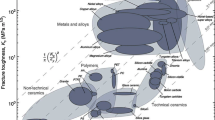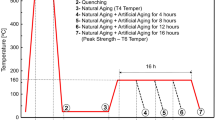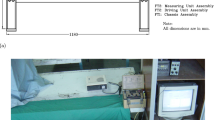Abstract
In the present investigation, comparative evaluation of the low cycle fatigue (LCF) of tube and forged Alloy 617M have been studied. Total axial strain controlled tests were performed on sub-sized specimens between 300 and 1023 K employing strain amplitudes ranging from ±0.25 to ±1 % at a nominal strain rate of 3 × 10−3 s−1. The alloy underwent cyclic hardening at all temperatures and strain amplitudes and the rate of hardening was sensitive to both temperature and strain amplitude. There were distinct differences in the LCF behavior of forged and tube products. The forged alloy exhibited better fatigue life than that of tube material and significant difference in the rate of hardening was observed between the material conditions at 1023 K. The variation in the LCF behavior of the two products was found to be associated with the difference in the initial microstructure. The grains of the tube product were equiaxed having 214 μm average size whereas a distribution of both large grains (average 65 μm) and clusters of small grains (average 15 μm) were found in the forged product. Microstructural investigations revealed mixed mode of failure for both the product forms.





Similar content being viewed by others
References
Alok M, Bhutani O P, Jayakumar T, Dubey D K, and Chetal S C, in Proceedings of Seventh International Conference on Advances in Materials Technology for Fossil Power plants, Electric Power Research Institute, USA (2013) p 53.
ASME, Boiler and Pressure Vessel Code, Part B, SB-166 and 167 (2013) p 207.
Bhanu Sankara Rao K, Schiffers H, Schuster H, and Nickel H, Met Trans A 19 (1988) p 359.
Srivastava S K, and Klarstrom O L, in Proceedings of Conference on Gas Turbines, ASME (1990) 90-GT-80.
Wright J K, Carroll L J, Simpson J A, and Wright R N, J Eng Mater Technol 135 (2013) p 031005-1.
Maier G, Riedel H, and Somsen C, Int J Fatigue 55 (2013) p 126.
ASTM Designation E 606-80, Part 10 (1980) p 694.
Kim S J, Choi P H, Dewa R T, Kim W G, and Kim M H, Proc Mater Sci 3 (2014) p 2201.
Chai G, Liu P, and Frodigh J, J Mater Sci 39 (2004) p 2689.
Guo X G, Guo J T, Yuan C, and Yang H C, in Proceedings of the Eighth Liege Conference on Materials for Advanced Power Engineering (2006) p 403.
Cornet C, Wackermann K, Stocker C, Christ H -J, Lupton C, Hardy M, and Tong J, Mater High Temp 31 (2014) p 226.
Burke M A, and Beck C G, Met Trans A 15 (1984) p 661.
Author information
Authors and Affiliations
Corresponding author
Rights and permissions
About this article
Cite this article
Mariappan, K., Shankar, V., Goyal, S. et al. Strain Amplitude and Temperature Effects on the Low Cycle Fatigue Behavior of Alloy 617M. Trans Indian Inst Met 69, 325–329 (2016). https://doi.org/10.1007/s12666-015-0784-5
Received:
Accepted:
Published:
Issue Date:
DOI: https://doi.org/10.1007/s12666-015-0784-5




